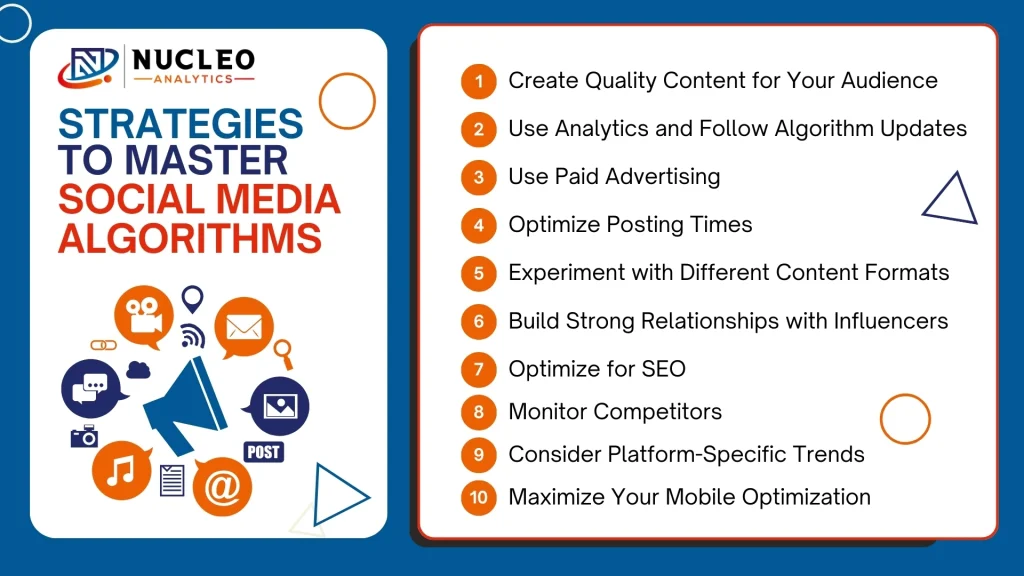Mastering Social Media Algorithms: How to Stay Ahead of the Curve!
Maintaining the curve in the often shifting sphere of social media may seem difficult. Businesses, influencers, and social media marketing firms must keep ahead of social media algorithms that are always changing to decide what material consumers view on their feeds. Maximizing reach and interaction depends on mastery of these algorithms. This blog will explore the nuances of social media algorithms and provide techniques to keep ahead of these developments, therefore optimising your social media presence.
Understanding Social Media Algorithms
Platform companies like Facebook, Instagram, Twitter, and LinkedIn employ sophisticated sets of rules and computations found in social media algorithms to provide material to consumers. These systems take timeliness, content relevancy, and user involvement among other elements. Based on their interests and interactions, users should be shown the most pertinent and interesting material.
Key Factors Influencing Social Media Algorithms:
- User Engagement: Likes, comments, shares, and saves are crucial. The more engagement a post receives, the more likely it is to be shown to other users.
- Relevance: Algorithms analyze user behavior to determine the relevance of content. Posts that match users’ interests and preferences are prioritized.
- Content Type: Different platforms prioritize different content types. For instance, Instagram may favor photos and stories, while LinkedIn might highlight articles and professional updates.
- Profile Interactions: The frequency of interactions between users and profiles affects how often content from those profiles appears in users’ feeds.
Strategies to Master Social Media Algorithms

To stay ahead of social media algorithms and enhance your online presence, especially when focusing on social media management for small businesses, consider implementing the following strategies:
1. Create Quality Content for Your Audience
Quality content is essential—focus on producing visually appealing, engaging, and informative materials. High-quality photos, videos, and well-written text can capture attention and drive interaction. Invest in professional tools and skills to enhance your content. Additionally, understanding your audience through analytics helps tailor content to their demographics, interests, and behaviors, ensuring it meets their needs and preferences.
2. Use Analytics and Follow Algorithm Updates
Track the performance of your social media posts using analytics tools to monitor metrics like click-through rates, engagement, and reach. Analyze this data to identify trends and adjust your content strategy accordingly. Additionally, stay updated with social media algorithm changes by following industry news, blogs, and official platform announcements, and adapt your approach to align with the latest updates.
3. Use Paid Advertising
Paid social media advertising helps you to be more visible and reach. Targeted advertising solutions on sites like Facebook and Instagram let you reach particular groups depending on demographics, hobbies, and activity. Complement your natural content approach with sponsored adverts.
4. Optimize Posting Times
Timing is crucial for maximizing engagement. Analyze when your audience is most active and schedule your posts accordingly. Experiment with different posting times and monitor engagement levels to find the optimal schedule for your content.
5. Experiment with Different Content Formats
Different platforms favor various content formats. Experiment with photos, videos, stories, reels, and live streams to see what resonates best with your audience. Diversifying your content can help you adapt to changing algorithms and reach a wider audience.
6. Build Strong Relationships with Influencers
Collaborating with influencers can enhance your brand’s visibility and credibility. Choose influencers whose audience aligns with your target market. Their endorsement can help your content reach new audiences and improve engagement.
7. Optimize for SEO
Social media platforms increasingly incorporate SEO principles. Use relevant keywords, hashtags, and tags to improve the discoverability of your content. Optimize your profiles and posts to align with search algorithms and increase your visibility.
8. Monitor Competitors
Watch how your rivals handle social media. Examine their material, degrees of involvement, and audience interaction. Learning from their achievements and mistakes might provide your own approach to insightful analysis.
9. Consider Platform-Specific Trends
Every social networking site boasts unique best practices and trends. Keep current with LinkedIn’s and Instagram’s trends. Following trends particular to your platform will help you remain current and interact with your audience more successfully.
10. Maximize Your Mobile Optimization
Make sure your material is mobile-friendly given the growing usage of cell devices for social media surfing. For mobile viewing, simplify photos, videos, and website connections to offer a flawless user experience.
Staying Ahead: Adapting to Algorithm Changes

Learning social media algorithms requires flexibility, strategic planning, and artistic expression together. Understanding the main elements influencing algorithms and applying sensible techniques will help you to keep ahead of the curve and improve your social media presence. Maintaining and increasing your online impact requires constant analysis of performance, keeping current with algorithm changes, and strategy adaptation. For more insights on optimizing your social media marketing strategy, check out our blog post The Power of Social Media Advertising for Your Business.
Advance Your Social Media—Speak with Us!
Our specialty at Nucleo Analytics is guiding companies over the complexity of social media algorithms. Our team of specialists offers customized social media management services meant to increase your website’s visibility and interaction. Whether your company is big or small, we can help you create a plan that keeps you ahead of the curve and guarantees your material reaches the correct audience and produces quantifiable results.
















